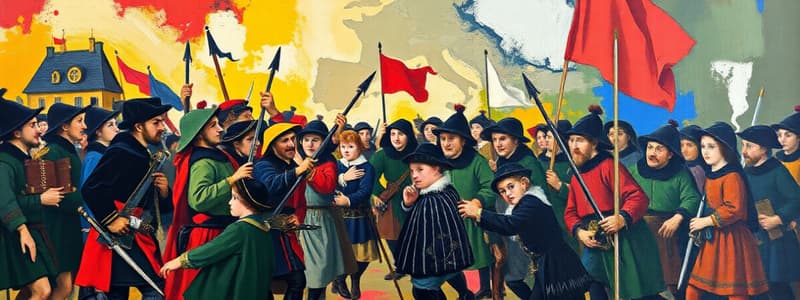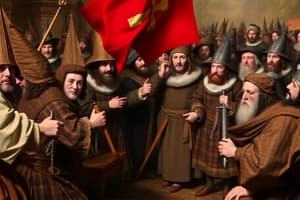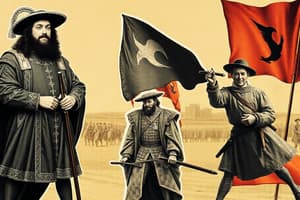Podcast
Questions and Answers
What was a significant outcome of the treaties made following the war?
What was a significant outcome of the treaties made following the war?
- Establishment of agricultural projects
- Unification of all German states (correct)
- Destruction of the major dam systems
- Guaranteed peace between Germany and neighboring countries
Which aspect of the economy was primarily affected by the events described?
Which aspect of the economy was primarily affected by the events described?
- Military expenditure and resources
- Agricultural stability and production (correct)
- Trade relations with external nations
- Industrial growth in Germany
What was a major setback mentioned that influenced the outcome of the treaties?
What was a major setback mentioned that influenced the outcome of the treaties?
- Economic ruin caused by previous conflicts (correct)
- Alliance formation with distant nations
- Rapid urbanization and migration
- Progressive reforms in labor policies
What phrase best describes the nature of the treaties between the involved countries?
What phrase best describes the nature of the treaties between the involved countries?
What thematic element is emphasized regarding the long-term effects of the treaties?
What thematic element is emphasized regarding the long-term effects of the treaties?
What triggered the Protestant revolt in Bohemia in 1618?
What triggered the Protestant revolt in Bohemia in 1618?
What role did the Catholic League play during the tensions in 1618?
What role did the Catholic League play during the tensions in 1618?
Who was the head of the Hapsburg family during the Protestant revolt in Bohemia?
Who was the head of the Hapsburg family during the Protestant revolt in Bohemia?
What was a primary factor leading to the growing tensions between Protestants and Catholics in Germany?
What was a primary factor leading to the growing tensions between Protestants and Catholics in Germany?
Which group did Ferdinand II rely on to suppress the Protestant uprising?
Which group did Ferdinand II rely on to suppress the Protestant uprising?
In which year was the Protestant Union, a coalition of Protestant states, formed?
In which year was the Protestant Union, a coalition of Protestant states, formed?
What was a likely consequence of the increasing number of followers gained by Protestant leaders?
What was a likely consequence of the increasing number of followers gained by Protestant leaders?
Which event is noted for igniting the conflict in Bohemia?
Which event is noted for igniting the conflict in Bohemia?
What led to the rise of absolute monarchs in Austria and Prussia during the early modern period?
What led to the rise of absolute monarchs in Austria and Prussia during the early modern period?
What significant agreement was reached to address religious conflicts in Germany during the early 16th century?
What significant agreement was reached to address religious conflicts in Germany during the early 16th century?
Which event is recognized as a major conflict fueled by the struggle between Catholic and Protestant princes?
Which event is recognized as a major conflict fueled by the struggle between Catholic and Protestant princes?
What was one impact of Frederick the Great's militaristic tradition in Prussia?
What was one impact of Frederick the Great's militaristic tradition in Prussia?
What characterized the relationship between Catholic and Lutheran princes in Germany following the Peace of Augsburg?
What characterized the relationship between Catholic and Lutheran princes in Germany following the Peace of Augsburg?
During which conflict did the religious differences between Lutheran and Catholic states become most pronounced?
During which conflict did the religious differences between Lutheran and Catholic states become most pronounced?
Which of the following best describes the outcome of the Peace of Augsburg?
Which of the following best describes the outcome of the Peace of Augsburg?
Which significant figure is not directly associated with the wars and conflicts discussed in the context of European monarchs?
Which significant figure is not directly associated with the wars and conflicts discussed in the context of European monarchs?
What was the primary role of Richelieu during the period discussed?
What was the primary role of Richelieu during the period discussed?
In which year did the significant events relating to Richelieu's influence occur?
In which year did the significant events relating to Richelieu's influence occur?
What was one of the main conflicts during Richelieu's time in power?
What was one of the main conflicts during Richelieu's time in power?
What strategy did Richelieu employ to strengthen his political power?
What strategy did Richelieu employ to strengthen his political power?
Which of these outcomes did Richelieu NOT aim for?
Which of these outcomes did Richelieu NOT aim for?
What was a major threat to Richelieu's authority that he sought to mitigate?
What was a major threat to Richelieu's authority that he sought to mitigate?
How did Richelieu's policies affect the national unity of France?
How did Richelieu's policies affect the national unity of France?
What impact did Richelieu's actions have on Protestant power in France?
What impact did Richelieu's actions have on Protestant power in France?
What was the significance of the Hapsburg triumph during the conflict?
What was the significance of the Hapsburg triumph during the conflict?
Which leader was associated with the Protestant cause during the conflicts mentioned?
Which leader was associated with the Protestant cause during the conflicts mentioned?
What was a characteristic of the forces led by Gustavus Adolphus?
What was a characteristic of the forces led by Gustavus Adolphus?
How did the conflict impact the concept of ruling in Europe?
How did the conflict impact the concept of ruling in Europe?
What was the geographic focus of the wars involving the Hapsburgs?
What was the geographic focus of the wars involving the Hapsburgs?
What tactical advantage did Gustavus Adolphus bring to his armies?
What tactical advantage did Gustavus Adolphus bring to his armies?
What was a common outcome of battles during this period of conflict?
What was a common outcome of battles during this period of conflict?
In what way did the Protestant cause gain support during these wars?
In what way did the Protestant cause gain support during these wars?
Flashcards are hidden until you start studying
Study Notes
The Thirty Years' War
- The Peace of Augsburg (1555) allowed German princes to choose the religion of their subjects, either Lutheran or Catholic.
- The Peace of Augsburg was short-lived due to the rise of Calvinism, which threatened both Catholics and Lutherans.
- The Thirty Years' War began in 1618 after a Protestant revolt in Bohemia against the Habsburg emperor Ferdinand II, who was Catholic.
- The Protestant Union (1608) and the Catholic League (1609) were formed, indicating heightened tensions between religious factions before the war started.
- The intervention of King Gustavus Adolphus of Sweden in 1632 shifted the tide of war in favor of the Protestants.
- Cardinal Richelieu of France supported the Protestants against Habsburg power, aiming to weaken Spain, a Habsburg rival.
- The war ended with the Peace of Westphalia (1648), which recognized the independence of the Netherlands and Switzerland, and granted religious tolerance in the Holy Roman Empire..
- The war resulted in widespread devastation in Germany, with an estimated population decline of 20 million to 18 million.
- The war slowed down the process of unification and development of a strong central authority in Germany.
The Rise of Powerful Monarchs
- Frederick the Great of Prussia: Built a strong military tradition and contributed to the development of a strong Prussian state. His leadership contributed to Prussia’s rise as a major power in Europe.
- Maria Theresa of Austria: Faced challenges from both Prussia and other European powers due to the Habsburg inheritance dispute. Her reign was marked by wars with Prussia, especially the War of the Austrian Succession (1740-48) and the Seven Years' War (1756-1763).
- Louis XIV of France: Known as the "Sun King," he reigned for 72 years (1643-1715) and consolidated his absolute power, shaping French royal absolutism. He centralized power, expanding the French bureaucracy, and engaged in wars to expand French territory.
Impact of the Thirty Years' War
- The war had a long-lasting impact on Germany and Europe.
- It created a climate of instability and mistrust, especially between Catholics and Protestants.
- It contributed to the development of strong, centralized monarchies and paved the way for later conflicts in Europe.
- The war significantly weakened the Holy Roman Empire.
Studying That Suits You
Use AI to generate personalized quizzes and flashcards to suit your learning preferences.




